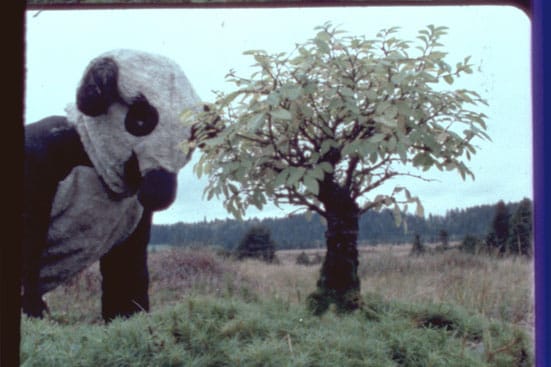11th October 2006 — 14th January 2007
If
you can fight your way through the hordes of screaming kids (and
big kids) currently enjoying Carsten Holler's slides at Tate Modern,
then an equally diverting, if a touch more cerebral experience
is to be found in a retrospective of Swiss duo Fischli & Weiss.
Having collaborated since the late 70s, and working across a range
of media (sculpture, photography, film, video and others), this
terrifically enjoyable exhibition provides a good overview of their
engaging, funny, and often fiendishly clever creations. Throughout
the eleven rooms of the exhibition, there is much that makes one
smile and often laugh out loud, but there is far more to their
work than just jokes and playful irony - although their delicious
sense of humour is clearly an integral part of what they do. One
of their many talents lies in making complex ideas and compositions
seem deceptively simple. This is exemplified in their most famous
work, The Way Things Go (1986-7), their ingenious and painstakingly
constructed film of cause and effect, the idea later hijacked for
an advertising campaign. For thirty minutes, the laws of motion
and chemical reaction are delightfully harnessed to compel an intricate
chain of objects and substances to move ever onwards across the
artists' studio, leaving a trail of destruction in their wake.
Various liquids seep and spill, things snap and smash and catch
on fire. There is something quite magical in witnessing hundreds
of usually banal things - tins, pots, buckets, bottles, kettles,
tables, chairs, planks, random odds and ends - being made to move
and function in odd, unexpected ways, and sometimes (memorably
a step-ladder) being wonderfully anthropomorphised. There's a striking
juxtaposition and pathos here too: the grimy, messy nature of the
objects along with the absolute precision that they momentarily
embody, after which, having gloriously fulfilled their function
in the chain, they inevitably fall, often literally, back to their
mundane, ignoble state.
An interesting decision has been to screen the film directly next to
video footage showing the artists in the process of making an early
version of it. This proves to be a fascinating work in its own right,
documenting the hours of trial and error spent trying to get a sequence
to occur successfully - a study in the processes of learning and
adapting, and in the satisfaction of things going right eventually.
The other film here is The Right Way (1982-3), in which the artists are
dressed in animal suits in order to become their preposterous alter
egos: Rat and Bear. The film depicts a supposedly epic journey across
various landscapes as the two of them traipse up mountains, through
rivers, across fields, towards some undefined place. They variously get
lost, encounter other (real) animals, forage for food and play tricks
on each other. The result is an eminently watchable film that succeeds
both as an absurdist buddy movie and a very amusing, ironic Odyssean
fable, but beyond that (and also encompassing it) as a surprisingly
moving meditation on our sad detachment from nature, our often
wrong-headed relationship to the land around us, and of an atavistic
yearning to reconnect. It's a compelling combination of the daft and
the poetic, of comedy and myth.
Profundity and silliness are again compounded in Questions
(2002-3), wherein hundreds of questions in several languages are
projected onto a wall, such as: 'Why does nothing never happen?'
'Should I fly to India in a balloon?' 'Have I ever been completely
awake?' and 'Should I make myself some soup?' Like many works in this
retrospective, it is a piece that mainly serves to inspire further
questions in the viewer. I found myself asking: 'Do I ask enough
questions?'
The notion of deceptive simplicity recurs throughout, not least in
the re-creation of the artists' studio and its accumulated junk, which
consists entirely of sculpted polyurethane reproductions, but which are
utterly indistinguishable from the real thing. As well as demonstrating
impressive craftsmanship, it becomes a perverse celebration of the
slippery nature of perceiving what is 'real', and the acknowledged
deceitfulness begins to feel queasily sinister. Something that is
remarkable about these artists is that just when it seems you've pretty
much grasped the mischievous way that their minds work, they hit you
with something incongruous, such as Apartment (1985), a disarming
sculpture depicting a bleak, entrapped maze of grey, barely functional
rooms. It's suggestive of a terrifyingly blank, clinical consciousness
- the sprawling residence in miniature of some absent psychopath.
There is much else here besides, including a series of forty
little clay tableaux which are enormous fun, and a great deal of
photography: from rather unpleasant double-exposures of gaudy flowers,
to melancholic shots taken at airports, to insanely balanced
assemblages of household objects, and a pointless, interminable
eight-hour slideshow displaying thousands of varied images (perhaps the
sole low point of the show).
DF
Tate Modern
Bankside
London SE1 9TG
http://www.tate.org.uk/modern
Open
Daily, 10am-5.50pm

The
Right Way, Peter Fischli & David Weiss, 1983
16mm film, 55 minutes
Copyright The Artists